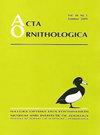三种地面筑巢雀鸟在印度东北部稻田收获后的巢地选择和筑巢成功率
IF 1.3
4区 生物学
Q3 ORNITHOLOGY
引用次数: 0
摘要
撂荒地作为潜在的筑巢栖息地,对农田地面筑巢的成功与否起着重要作用。亚洲国家利用大片土地作为稻田,这些稻田及其毗邻的栖息地是印度次大陆约3%鸟类的繁殖地。在一个热带农业区,我们调查了收获后稻田和相关栖息地对三种雀鸟筑巢成功的贡献。2016年2月至2017年6月,在印度东北部西孟加拉邦南部以休耕残茬为主的复杂农田中,研究了90对东方云雀Alauda gulgula (n = 25个巢)、孟加拉灌木云雀Mirafra assamica (n = 32个巢)和水田Pipit Anthus rufulus (n = 33个巢)的筑巢生态。在有未刈水稻基地的残茬田、邻近已刈或未刈的其他田和堤防中发现了巢。巢的位置及其微生境似乎是影响巢地选择的最重要因素。云雀、丛云雀和小云雀的筑巢成功率分别为48%、34.4%和21.2%。模型估计的恒定日存活率(DSR)在0.90-0.95之间。三种物种在水稻基地的巢存活率提高了1-5%。水稻基地的巢比露天生境的巢存活率高6.5%。在开放式微生境中,不同种类的巢存活率均较低。模型拟合优度表明,巢存活率主要受微生境和物种变量的共同影响。结果表明,收获后稻田的水稻基地可能对雀鸟的巢生存起重要作用。本文章由计算机程序翻译,如有差异,请以英文原文为准。
Nest Habitat Selection and Nesting Success of Three Ground Nesting Passerines in Post Harvested Rice Fields of North East India
Set aside fields act as potential nesting habitat and play an important role in nest success of ground nesters in farmlands. Asian countries utilize vast areas of their land as rice fields which along with adjoining habitats act as breeding ground for around 3% bird species in the Indian subcontinent. We investigated contribution of post harvested rice fields and associated habitats in nest success of three passerines within a tropical agricultural area. Nesting ecology of 90 pairs belonging to Oriental Skylark Alauda gulgula (n = 25 nests), Bengal Bush Lark Mirafra assamica (n = 32) and Paddyfield Pipit Anthus rufulus (n = 33) was studied from February 2016 to June 2017 in a complex of agricultural fields dominated by fallow stubble in the southern West Bengal, North East India. Nests were found in the stubble fields having uncut rice bases, adjacent cropped or uncropped other fields and levees. Location of the nests and their microhabitats seemed to be the most important factors concerning nesting habitat selection. Nest success was 48%, 34.4% and 21.2% in Skylark, Bush Lark and Pipit respectively. Model estimate of constant Daily Survival Rate (DSR) ranged between 0.90–0.95. Nest survival increased between 1–5% at rice bases for the three species. Pipit nests at rice bases showed 6.5% higher survival rate than open habitat. Nests at the open microhabitat had low nest survival irrespective of species. Model goodness of fit suggested that nest survival was affected mostly by combination of microhabitat and species variables. Results suggested that rice bases in post harvested fallow rice fields might play an important role in nest survival for passerines.
求助全文
通过发布文献求助,成功后即可免费获取论文全文。
去求助
来源期刊

Acta Ornithologica
生物-鸟类学
CiteScore
2.10
自引率
0.00%
发文量
14
审稿时长
>12 weeks
期刊介绍:
Publishes scientific papers (original research reports, reviews, short notes, etc.) and announcements from all fields of ornithology. All manuscripts are peer-reviewed.
Established in 1933 as Acta Ornithologica Musei Zoologici Polonici, since 1953 continued under the present title.
Published twice a year by the Natura Optima Dux Foundation under the auspices of the Museum and Institute of Zoology, Polish Academy of Sciences.
 求助内容:
求助内容: 应助结果提醒方式:
应助结果提醒方式:


